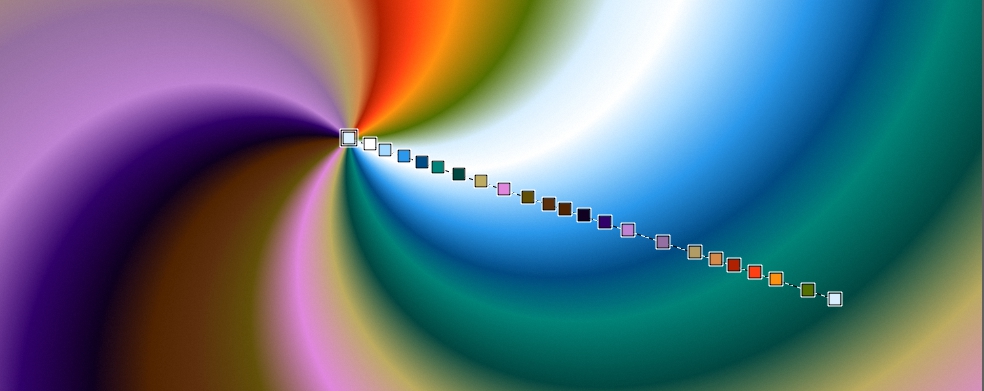
| • | To edit a gradient interactively |
| • | To edit a gradient preset |
After you draw a gradient with the Interactive Gradient tool, you can edit it in the document window. An interactive gradient control appears, which marks the transition from one color to another. The direction and size of the gradient depend on where you first click in the document window, the distance that you drag, and the direction in which you drag. Each color in the gradient fill is represented by a square node on the interactive gradient control. You can modify the gradient appearance by repositioning nodes, adding and removing nodes, and changing the color of nodes.
| To edit a gradient interactively |
|
| 1 . | Click the Interactive Gradient tool |
| 2 . | Click the Preset flyout button |
| Make sure the Edit nodes option on the property bar is enabled. |
| 3 . | Draw a gradient. |
| 4 . | Perform a task from the following table. |
|
Tip: To snap the gradient line to the horizontal, vertical, or diagonal axis, hold down Shift key while you drag.
|
|
|
Tip: You can also reverse the order of colors in the gradient by clicking the Reverse Gradient Direction button
|
|
|
Click a node, click the Color chip, and choose a color in the color picker.
Tip: You can also change the color by clicking a node, clicking the Gradient Node panel toggle button
|
|
|
Click anywhere along the interactive gradient control, click the Color chip, and choose a color in the color picker.
Tip: You can also add a color by clicking anywhere along the interactive gradient control, clicking the Gradient Node panel toggle button
|
|
|
Click a node. Click the Gradient Node panel toggle button
|
|
|
Click a node. Click the Gradient Node panel toggle button
|
|
|
Click a node. Click the Gradient Node panel toggle button
|
| To edit a gradient preset |
|
| 1 . | In the Gradient Libraries panel (Window |
| 2 . | Click the Edit Gradient |
| 3 . | In the Edit Gradient dialog box, perform a task from the following table. |
|
Click in the color ramp bar where you want to add a color, click the Color chip, and choose a color in the color picker.
A new color was added to the gradient by adding a node to the color ramp bar. |
||||||||||
|
Click a node in the color ramp bar, and click Delete Node.
|
||||||||||
|
Click a node in the color ramp bar and move the Opacity slider.
|
||||||||||
|
Disable the Linear check box and drag the Color Spread slider to control the color smoothness at each node.
|
||||||||||
|
The Color hue options allow you to change the hue of the blend within that segment. Select one of the following options in the Color Blend Method area:
Tip: To understand this concept better, refer to the standard display of the Color panel (Hue Ring and Saturation/Value Triangle), and note the order of the colors on the Hue Ring.
|
||||||||||
|
Press Option + click (macOS) or Alt + click (Windows) in the color ramp bar.
|
| 4 . | In the Gradients panel (Window |
| 5 . | In the Save Gradient dialog box, enter a name for the gradient. |
|
Click the Preset flyout button
A gradient with low spiral tension (left) and high spiral tension (right) |
|||||||
|
Drag the Ramp Angle slider or type an angle in the corresponding numeric value box.
|